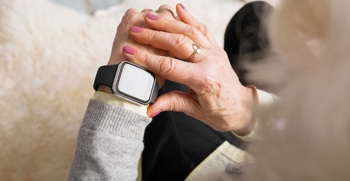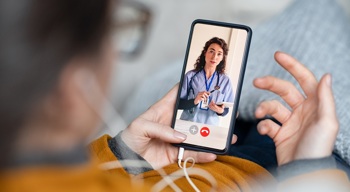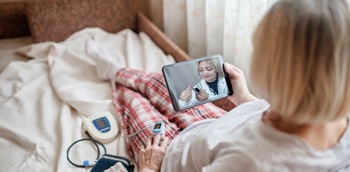
What do you need to support your virtual wards?
Virtual wards have been trialled since 2009 and more significantly again since 2018. Rapid deployment out of necessity during the height of the Covid pandemic has shown the benefits and drawbacks of virtual wards, which has led to a new wave of trials across England and Northern Ireland. These three reports into NHS trusts highlight areas needing support:
1. South Eastern Health and Social Care Trust
Janice Colligan, an Operations Manager with South Eastern Trust Virtual Ward, reported on her trust’s virtual ward outcomes in 2015. The Northern Ireland trust was one of the first ever virtual ward trials, with two periods in 2009 and again 2010 to test the impact of hospital care at home.
Aside basic kit requirements, such as staff smartphones for patient communication, the following was a major drawback highlighted in the report: “Patients were initially identified using a computer algorithm (Kings Fund, 20054) but this proved to be time-consuming and inefficient with issues around coding. Therefore patients were identified by GPs and referrals from members of the multi-professional integrated team including Allied Health Professionals, District Nurses and Social Care staff. Patients were also identified through the review of the GP Chronic Disease Register.”
A lot has changed in healthcare software in the 13 years since then, but it shows the necessity of a dependable system to enable time to be saved for staff in the processing of patients.
2. Croydon Health Services virtual ward
The Croydon Virtual Ward evaluation report about a Covid virtual ward was published in December 2021. The feedback showed great benefits from the monitoring solutions provider, Current Health, but concluded that “Trust systems need to be developed to enable structured collection of data and integration with Current Health observations data.”
The key takeaway point from the report said: “Staff raised the following as key factors for success: The ward being run by community (not acute) services, pathways in place to ensure emergency treatment is accessed when needed, upskilling staff on continuous monitoring and knowing when to use continuous versus spot monitoring, and having a cross-system multidisciplinary team, among others.”
3. University Hospitals Leicester NHS Trust
Leicestershire Partnership NHS Trust and University Hospitals of Leicester NHS Trust Covid-19 Virtual Community Ward Service worked together to deliver another instance of virtual ward care – again in response to the Covid-19 pandemic.
The report – An Economic Evaluation of a virtual Covid Ward in Leicester, Leicestershire, and Rutland – said more of the same; a good virtual ward needs home monitoring kits to take patient vitals, software to relay that data back to the healthcare professionals, and an initial commitment of funding to take the big step to establish a virtual ward – funding that will then be repaid by the care savings made over time.

Best virtual ward technologies
As virtual wards develop and evolve, so too will our understanding of their day-to-day operations and how to get the best out of them. By this point those in charge will likely realise they need greater cooperation and coordination between trusts and departments. Integrated Care Systems (ICSs) were introduced by the NHS to address this, and virtual wards have to play their part.
The virtual ward reports above show that success comes through proper collaboration between organisations under the ICS umbrella, but also interoperability between software solutions for a quicker sharing of data.
Remote Monitoring: This is the default technology needed to facilitate ‘Hospital at Home’. It almost goes without saying that this is one of the best virtual ward technologies, because without it there’s no ability to provide care away from a hospital ward. Wearable devices and other monitors have evolved to the point of being conveniently sized whilst performing important technical readings, and communicating these back to partner software so that clinicians can assess a patient’s condition.
Remote monitoring also collects information over time, building up a picture of a person’s behaviour and matching activity against these trends. This pattern recognition not only helps spot long-term declines in things like mobility, but also helps provide clinicians with crucial data to build up a bigger picture (regionally or nationally) about the signs of declining health and subtle indicators.
Patient records: Electronic patient records (EPR) are the first virtual ward technology that needs to be pursued, giving NHS trusts and local authorities one central record to operate from and to update. This will ensure accuracy in patient information and keep things up-to-date.
Patient flow: Tracking a patient’s journey through the hospital isn’t a new phenomenon, but digital monitoring means that administrators can assess trends in patient needs or demands, and clinicians can accurately track a patient’s whereabouts and circumstances – useful for both safety but also identifying any risk areas that may be impacting recovery.
Bed Management: This ties in with the patient journey. Many hospitals already have a bed management system in place. By working with the virtual ward teams, those cared for at home will be tracked in the separate virtual ward, freeing up beds to prioritise the most urgent cases.
Care Commissioning: A key tool for virtual wards is a care commissioning software, which is currently helping the Discharge to Assess process decide between home care or a care home. Virtual wards are separate to these discharge procedures, but the principles are the same: people are moved out of the hospital and require a clear plan of action to communicate with them and provide regular updates and check-ups. Their care and equipment still need to be provisioned and having a commissioning tool that can do this easily, within a virtual ward solution, means it’s quick and easy to safely put care in place.
Social prescribing: Community care is being keenly pursued as part of a plan to have a wider healthcare foundation. By encouraging community activity and interaction, patients are receiving additional support. This could be through groups, events, or activities, but it helps with both stimulus (physical or mental) and as regular observation of a person’s wellbeing; potentially catching a problem before it becomes serious. Community support has also been proven to reduce re-admission.

Access solutions
The Access Group is already accredited as a Framework Agreement Supplier by the NHS Shared Business Services (SBS) for our digital telecare solutions – better known as Access Assure. This is our monitoring solution, providing hardware and software to NHS trusts, local authorities, and other departments who need it, but it is simply the first step a virtual ward should be looking at in terms of tools.
We come back to the previous point about interoperability. This often proves a virtual ward challenge for software providers, many of whom simply provide one or two products. At The Access Group, we believe in working with others to ensure that healthcare professionals have what they need to provide care. We have in some cases created APIs (Application Programming Interfaces) helping link our software to that of other providers and will happily work to integrate existing systems, so all information is available to those that need it.
Access does have a suite of software solutions available for many healthcare pathways though; all of which can communicate with each other reliably and with ease.
- Access Assure
Our remote monitoring solution is Access Assure. It is a combination of physical kit to use in the home, such as the Home Hub and other wearables, and software to collect and collate patient data. At a basic level Assure operates like a traditional alert system, but all of these devices communicate and then report back to whichever agency – local authority, virtual ward, care organisation – to provide them with real-time patient information and vitals. - Access Adam Care Commissioning
Access Adam is designed to procure home care services or to arrange continuing healthcare provision and can accommodate virtual ward decisions and action plans. - Access Patient Flow Manager
Our patient flow tool is designed to track patient movement through the healthcare system from admission to discharge – all displayed on a virtual ‘whiteboard’ with their details and important information about their needs or risks. - Access Rio EPR
Electronic patient records are handled by Rio EPR. This provides a centralised patient record, to minimise data errors, and can quickly communicate patient information to healthcare professionals or other clinical teams and departments. - Access Elemental
Access Elemental handles social proscribing. It links care pathways and healthcare professionals to community workers and volunteers, as well as connecting to non-clinical programmes, services, and events in their local community. This is good for building community foundations to elevate the quality of public healthcare and to help catch deterioration quicker, which in turn often results in quicker and more successful recovery.
The NHS is clearly keen to modernise, and virtual wards are a part of that. The appetite for change is gathering speed and will become a snowball effect over the next decade. There will come a time in the next two or three years when the NHS needs further help, and the risk is that the healthcare technology market is currently saturated for monitoring support and gadgets to achieve this but for little else.
The Access Group stands ready with a wealth of technical experience and a range of software solutions to enact any ideas the NHS may have. We work directly with NHS trusts, local authorities, and private sector providers across primary and secondary healthcare, social care and the care sector to gain their insight and assess their needs, whilst tailoring our tools to help their care provision. These relationships are testament to the fact that Access is the provider to trust in the years to come as modern healthcare rapidly catches up to the digital age.

 AU & NZ
AU & NZ
 SG
SG
 MY
MY
 US
US
 IE
IE

